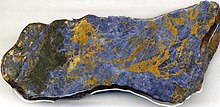Smergel

Smergel er en naturligt forekommende blanding af metaloxiderne, korund og magnetit. Materialet var tidligere meget anvendt som slibemiddel grundet dets store hårdhed.
| Spire Denne naturvidenskabsartikel er en spire som bør udbygges. Du er velkommen til at hjælpe Wikipedia ved at udvide den. |
Medier brugt på denne side
Forfatter/Opretter:
- Urutseg: Blank_template.svg
- AllyUnion, Stannered: Science-symbol-2.svg
- Ain92: combination
Science stub icon.
Forfatter/Opretter: James St. John, Licens: CC BY 2.0
Corundite (emery rock) (cut, wet surface, 10.0 cm across) with blue corundum/sapphire and yellowish-brown calcite. The bluish-brownish corundite is a fracture filling. The host rock can be seen on the left side of the specimen - a chloritoid-hematite-rich diasporite (dark green = chloritoid; red spots = hematite).
Corundite is a remarkable metamorphic rock. The sample shown here has an attractive bluish color and wisps of yellow-brown. Its composition and origin are quite unusual. Corundite (a.k.a. emery rock) is dominated by corundum, a very hard (H ≡9) aluminum oxide mineral (Al2O3). This particular rock has blue corundum, therefore it can be called sapphire. Rock-forming corundum is rare.
This material comes from the Naxos Emery Deposits on the island of Naxos in the Aegean Sea. Naxos is dominated by metamorphic rocks and some igneous rocks. Much of the island consists of marbles (originally limestones). Some of the original limestones had lenses of bauxite, which is a rock having aluminum hydroxy-oxide minerals. Upon metamorphism, the limestones were converted to marbles and the bauxites were converted to diasporites (= diaspore (AlO·OH)-dominated rocks) (= very dark green area on the left side of the first photo).
Upon further metamorphism, the diasporites were converted to corundites plus water. High fluid pressures fractured the rocks, and the fractures got filled up with corundite.
Metamorphism on Naxos occurred during the Cenozoic in two main phases. A high-grade metamorphic event occurred during the Eocene, at about 40-50 million years ago. A second, intermediate-grade metamorphic event occurred during the Early Miocene, at 16-20 million years ago.
Info. synthesized from:
Urai & Feenstra (2001) - Weakening associated with the diaspore-corundum dehydration reaction in metabauxites: an example from Naxos (Greece). Journal of Structural Geology 23: 941-950.
Feenstra & Wunder (2002) - Dehydration of diasporite to corundite in nature and experiment. Geology 30(2): 119-122.
